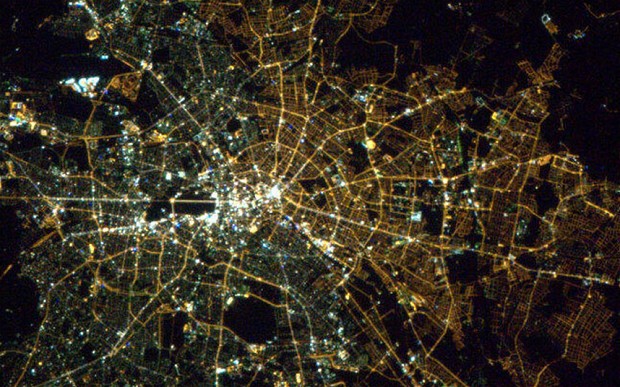One of things that I love about science-fiction writing is that it gives me an opportunity to really write about how the legacy of past is still shaping our lives today.
Back in 2014, I wrote about how from space you could still trace the divide in Berlin, even though it’s long since been demolished. How? Because East and West Berlin used different kinds of street lights, and even though the city is unified, changing them out was really expensive. So, 25 years after the fall of the Berlin Wall, the lights were different enough they could be used to trace its former path.
Here’s the amazing picture of the divided city.

And yet… many things do eventually change.
The economics of new kinds of light mean that cities all over the world are changing their streetlights to LEDs. Finally, it does make sense to switch out lights.
And while LEDs save both money and energy, it has some interesting external consequences. For example, LED lights are affecting the look of Hollywood movies. Here’s a story that dives deep on color temperature:
After Michael Mann set out to direct Collateral, the story’s setting moved from New York to Los Angeles. This decision was in part motivated by the unique visual presence of the city — especially the way it looked at night. Mann shot a majority of the film in HD (this was 2004), feeling the format better captured the city’s night lighting. Even the film’s protagonist taxi needed a custom coat to pick up different sheens depending on the type of artificial lighting the cab passed beneath. That city, at least as it appears in Collateral and countless other films, will never be the same again. L.A. has made a vast change-over to LED street lights, with New York City not far behind. Read on for why Hollywood will never look the same again — on film or otherwise.
This image is originally from the LA Bureau of Street Lighting and shows the big change.

And when Rome started getting new LED streetlights, people were not happy. I’m not sure this amazing quote would be believed if it were published anywhere else than in The New York Times:
“This used to produce a light with a golden halo, that soft and welcoming light that envelops you,” Ms. Naim lamented, nodding to one of the cast-iron lampposts that dot the city center. Alas, no more.
“I don’t want to make this personal,” Ms. Naim said, dramatically covering her eyes while passing through a bar-lined piazza, “but these horrible lights, mamma mia!”
Mamma mia, I love that quote!
This topic really hits on several themes I know I investigate over and over again in The Lattice Trilogy. Not just “the legacy of past technology” but also the idea that as technology gets better (LEDs save money and energy!) it also gets worse (LEDs make every city look the same and can be too harsh). It’s one of the central debates over the Lattice itself.
Drawn, in part, by paying a lot of attention to streetlights apparently.